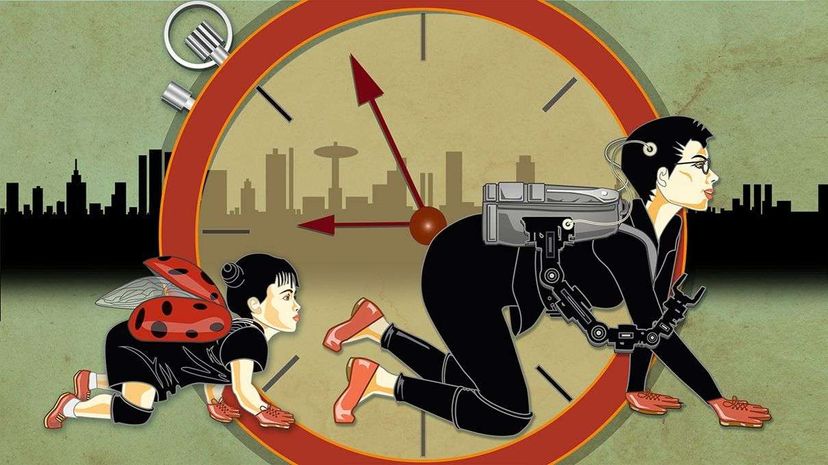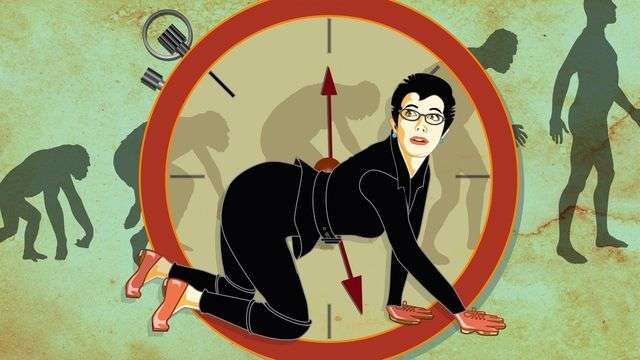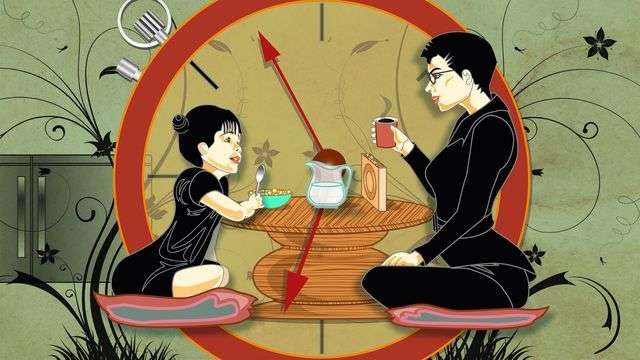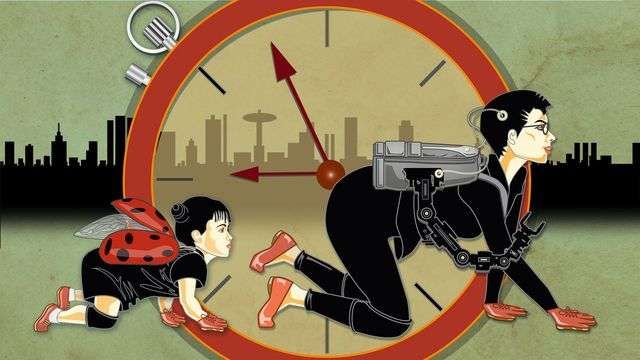
Believe it or not, the human spine wasn't built for vertical use. Vertebrates have been around for 500 million years, but primates that walk upright — aka the hominin clade, of which we Homo sapiens are the only extant species — took the first steps 6 million years ago. We became fully bipedal only 1.9 million years ago.
In other words, the vertical spine has been in use for only 0.38 percent of vertebrates' existence.
Advertisement
Our hominid ancestors hacked its inherently horizontal design. They insisted on standing to appear larger, to quickly cover open landscapes, to widen their views beyond others' butts, and most importantly, free their hands.
As a result, our spines don't function in the way they were originally intended, even with the evolutionary workarounds (wider hips, stronger knees). And it's compounded by our chair-sitting lifestyle. Hence the astounding figure that 80 percent of adults will experience back pain in their lifetime.
What if we returned our spines to their original position and quit walking upright?
Stick with us as we imagine what 24 hours in a quadrupedal world would look and feel like. We'll set it in the future, with homes and public spaces transformed for an on-all-fours world.

24 Hours in the Life of a Human Quadruped
I fall asleep reading about the humans who propped themselves up on pillows and foam-filled mattresses to allay their aches and pains from their upright pursuits. I awake refreshed on the quilt-covered floor of my room.
I pull on my hand and knee pads and scamper off to the bathroom. There's a hole in the ground with an automatic retractable cover. Business here is swift and conducive to the natural form of, ahem, voiding. I scuttle over to the wash basin in the floor and peer at my image in the mirror surrounding it and then sit upright as I brush my teeth, looking into a second mirror on the lower part of the wall, checking out my curved back. Which hand, knee and foot shoes should I wear today?
My 6-year-old daughter walks into the bathroom, upright and swaying side to side unsteadily. “I am a giant Homo sapiens,” she says giggling, and then tumbles down to my side and scrambles up onto my back for a ride to the kitchen.
The refrigerator is low and spans the width of a wall. Our kitchen table is retro. It's raised off the floor, but only by about a foot (0.3 meter) to accommodate our crossed legs.
The house we live in is incredibly old; it was modified for the All Fours It movement long, long ago and is on the historic homes register. When my daughter lets out a peal of laughter it bounces against the drop ceiling. Some people in historic homes choose to not drop their ceilings. Instead they keep the excessive feet of ceiling for storage and access it with elaborate ropes and ladders.

Bound for School and Work, Horizontal-style
After breakfast my daughter and I strap on our backpacks. They're made out of graphene and hardly weigh a thing. Robotic arms tuck into the backpack, and they serve as surrogate hands for when we're using our knuckles to walk. When we connect the wire from the backpacks to the base of our necks, where we have brain implants, the arms unfurl from the sides. My daughter's backpack is painted red with black dots to mimic a ladybug, and her robotic arms sport the same pattern so that when the arms rise they look like wings.
One of my backpack hands activates the front door flap to open, and we pass through and out to the street where we nearly miss the school train. The train supervisor is tilted over the controls, and she overrides the automatic system to allow the door to open again for us. My daughter jumps from the corner to the rope hanging in the doorway, swings herself inside and waves goodbye with her backpack hand. The supervisor is just about to release the handbrake when she deftly spins around in her 360-degree chair to admonish a child who's walking upright in the aisle. The kids laugh uproariously.

I scamper off to the gym to increase my core strength. Although our species has adapted well over the generations, we still have the ghosts of bipedal bones and musculature. Our abdominal muscles aren't as robust as they should be to support our quadrupedal locomotion. Our neck bones haven't quite shifted in place to support our horizontal spines, and our long thigh muscles sometimes need the occasional massage since they're geared toward long strides rather than short ones.
Some people rely on additional support from their backpacks — arms that can extend to the ground and help take some of the weight off. But it's usually the elderly or infirm that resort to these models since there's a debate about assisted limb usage in the medical community.
One camp of researchers claims that using our biological arms just for walking results in less brain stimulation, while another camp claims that our backpack arms have easily been adopted into the overall body schema — after all, our brains are telling these limbs what to do — so that there's plenty of stimulation.
My backpack vibrates, and I feel a slight squeeze around my rib cage and back. It's my daughter thinking me a hug, and I "hug" her back wirelessly, knowing that her backpack is gently contracting in response.
I work in a customer service call center for a major backpack provider. The hours are long, but they go by fast. This is in part because the implant I have for work shifts my mind over exclusively to customer communications. I get the thoughts of others all day long melded into auto responses determined by an algorithm. And these usually involve requests to help patch customers through upgrades or report spotty areas where their backpacks aren't receiving data.
The other reason it goes by fast is that our chair pods complete full rotations every 30 minutes – you feel like time is passing by. Like you're in constant motion. Some of us call our chairs "pit roasters." That's because when you climb atop of the main support and lay over it, locking your feet in, it can feel a bit like straddling a kabob skewer. But the open-aired cocoon that locks over it is actually beautiful. You can program it to glow, play your favorite music or shut out office noise. Studies say it increases productivity, satisfaction, blah, blah, blah. There are even built-in bicycle pedals if you want to get exercise.
Mostly though, I think the pit roaster keeps us from looking at one another's butts all day. It's a favorite pastime of quadrupeds, and a major distraction.
Walking Upright, Only a Dream
I switch off my work implant and get a thought message from my daughter that she's on the way home. When I meet up with her she's excited about a volcanic eruption simulation she was able to enter today. She was close enough to the lava to feel the heat, and the class was able to test the atmospheric concentrations of carbon dioxide. (Her school has pit roasters, too, though outfitted with virtual reality vision.)
She's gesticulating wildly, describing a spurt of pyroclastic clay, and I notice that the tread is coming off her knuckle pads. I make a mental note that directly kicks off an order into a company to ship new pads to us by morning.
When we arrive home the oven has already prepared our meal — tikka masala. We close our eyes and share our favorite scenes of the day, and I make sure to run the KidFilter on my thoughts so none of the watercooler chat comes her way.
Then it's off to the floor to slumber. We remove our backpacks, and I admire the slight arch in my daughter's back, a standard of beauty that's easily fetishized by the media — with some getting implants to create a more hunched profile.
I drift off to sleep, the shadows moving in and out, morphing into a dream of towering ancestors, ever-constructing perches to take them higher and higher. I am one of them, and I stagger over vast lands on stilts, unsteady and always lurching forward until, finally, I curl myself to ground and feel its gravity centering me to my patch of earth.
If our quadrupedal thought experiment piqued your interest, look for the Stuff of Life podcast and interview with the author of "GoatMan: How I Took a Holiday from Being Human" in May. Written by Thomas Thwaites, the nonfiction book chronicles Thwaites' quest to transform himself into a goat. Really.
Advertisement